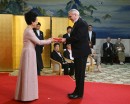Praemium Imperiale

October 21 was held a grand ceremony of delivery of the imperial awards. The Japan Art Association (JAA) has named French architect Dominique Perrault winner of the 2015 Praemium Imperiale International Arts Award. Lauded for his "wildly imaginative [or] abstractly minimal" designs, Perrault is known for masterfully blending innovative works with their context.
The winner medal was presented to the architect by Honorary Patron of the Japan Art Association Princess Hitachi in an awards ceremony held in Tokyo.The premium rate is an honorarium of 15 million yen (more than $ 120000) and a testimonial letter.
The Praemium Imperiale is a global arts prize awarded annually by the Japan Art Association. Since its inauguration in 1989, it has become a mark of the arts. Six nomination committees, each chaired by an International Advisor, propose candidates in five fields: Painting, Sculpture, Architecture, Music and Theatre/Film.
The artists are recognized and awarded for their achievements, for the impact they have had internationally on the arts and for their role in enriching the global community. Perrault joins a small handful of architects who have received the award, including James Stirling, Tadao Ando, Alvaro Siza, Richard Rogers, Jean Nouvel, Toyo Ito, Zaha Hadid, Peter Zumthor, David Chipperfield, and Jacques Herzog and Pierre de Meuron.
Dominique Perrault is an architect who primarily steeps himself in the history, environment, and special local nature of a building’s site before going to the drawing board to design it. His innovative buildings blend into the environment without spoiling those features. Well known for his unique ideas, he sometimes embeds his buildings deep in the ground and often uses the material of “metal mesh” as a key architectural feature in his works.
“My starting point is the empty space and how to design it,” Perrault explains. “We need empty spaces in our homes to make them livable. In the cityscape, this emptiness is sometimes viewed as positive, but sometimes as rather unsettling. My primary focus is on finding ways to enhance the quality of these empty spaces.”
The National Library of France, which brought him international renown as an architect, was full of innovative ideas. Among his works in Asia, Dominique Perrault designed the No Theatre in Tokamachi, Niigata Prefecture, the Fukoku Tower in the Umeda business district of Osaka and the Ewha Women’s University Campus Center in Seoul, Sou. Ongoing projects include the repurposing of the Dufour Pavilion in the Palace of Versailles and the new Longchamp race track in Paris.
Materials, images and photos are courtesy of
Dominique Perrault Architecture and Japan Art Association / The Sankei Shimbun






